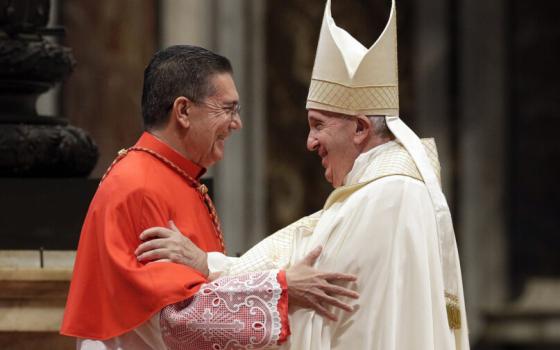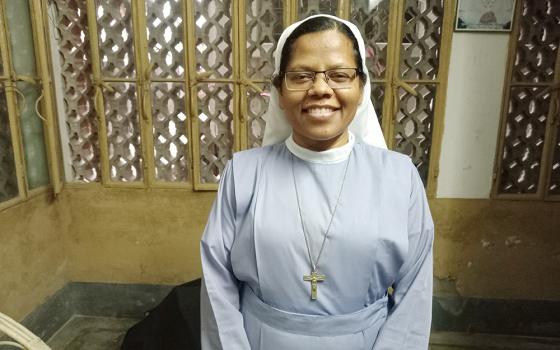
Commentary
We were visiting family over the holidays and attended Mass at a parish where there was evidence of the ongoing tussle with the new liturgy. At one point during an attempt to keep up with that unnecessarily unwieldy construction of "Lord, I am not worthy that you should enter under my roof," someone nearby got tongue-tied and finished it off with, "Whatever."
I chuckled. It was good to laugh about it.
Those of us who by virtue of our circumstances (religion writers, for instance, or professional liturgists) know the back story to the changes are more likely than not to bristle at the rather saccharine presentation of reasons for the changes. The reality, of course, is that the changes were as much as anything else about power and maintaining control, rolling back the language that came to reflect the changes in theology and community disposition that occurred as a result of the Vatican Council of the 1960s. Yes, yes, it was to restore some of the majesty and awe, some of the precision of the Latin upon which the prayers are based, to restore anew the sense of mystery and to re-establish the distance between priest and people.
But those who know the story in its fullest details know that the "new" translation, a reform of the reform, was actually commandeered by a group of men who met secretly and, in a matter of days, undid a process that had occurred under two popes and with the wide participation of bishops and professionals in the English-speaking world. (See Fr. Richard McBrien's writing on the same subject here.)
Even after the initial ambush of the translation and the remaking of agencies responsible for the translation, the secret manipulations continued. That's why even some who were on board for the reform of the reform bolted, angered at the process -- or rather, lack of it. Some of us are privy to far more information than most in the pews have the time or inclination to take in. And I say, good for them.
So I am one of those who simply has to get over it for the moment. The first Sunday I attended a Mass in which the new language was used, I decided to adopt a Ghandian strategy toward the ecclesiastical shenanigans. I decided that I could absorb the silliness, knowing that it really didn't alter much. "Whatever" makes the point.
On Christmas morning, another related point came to the fore, one that's fascinated me and that underpinned much of what I learned writing the book The Emerging Catholic Church: A Community's Search for Itself. The simple reality is that the church has changed dramatically in the last half-century and shows no signs of slowing down the change curve. The Catholic community is living in a state of flux. You can apply all the old language you want, you can put up altar rails and resist having female altar servers and insist that lines be drawn anew between people and priests with their ontological distinction. But all of that won't change the facts on the ground where, despite all of the new line-drawing and determining of who's in and who's out, one keeps running into the intersection in which need meets theology. And all at once, we're struck with how different things have become.
Before the Mass began on Christmas morning, the priest, by this point fully vested, went to the front of the church, got hold of the microphone and announced that because of reasons unexplained, none of the Eucharistic ministers who were supposed to be on duty showed up.
So he needed volunteers. Six of them. Yes, he pointed, you and you and you, and so on. He quickly had the six. "And we'll figure out the wine and the bread" on the run, he said.
When I got home, I looked up the old "prayer for a worthy communion" in my tattered St. Joseph Daily Missal that sits on my bookshelf, a remnant, with its worn ribbons, as unused today as the antique Remington typewriter a friend gave me years ago. There I found the phrasing as I had known it as a child: "Lord, I am not worthy that Thou shouldst come under my roof."
And that brought back vivid memories of that time of certainty and clarity. When the rectory was filled with priests and the convent was full of nuns whom I would occasionally encounter on my way to 6:30 a.m. Mass. They crossed the street with veils in front of their faces, two by two, specters moving like those Russian dancers in long dresses who seem to dart about on a cushion of air.
There was, to be sure, mystery, separation between the ordained and all other mortals, rules for everything, answers to everything. We've learned since that there was considerable corruption, too, and we've learned that faith based on certainty isn't faith at all. Neither I nor any of the priests I knew at the time could ever have imagined that one day a celebrant would get up before the congregation on Christmas morning and seek volunteers to help distribute Communion.
We are living in that tension between the yearning for the old certainties -- the old prayers that "worked" in a less complicated time, the clean lines that everyone understood -- and the reality that priests today have to do something as informal and lacking in decorum and majesty as asking for volunteers to aid in one of the most sacred moments in our liturgy.
The tacit admission (and I must note here, the priest in this instance seemed to have no problem at all dealing with the informality; in fact seemed to enjoy it) is that priests can no longer do it alone. The moment for me was symbolic of the sometimes holy chaos evident in contemporary Catholic life and the approach -- "Can you give me some help?" -- that works best where there is a sense of ownership, of genuine community, of a people educated to those tasks.
About that language that would suggest something other? Whatever.
[Tom Roberts is NCR editor at large. His email address is troberts@ncronline.org.]



